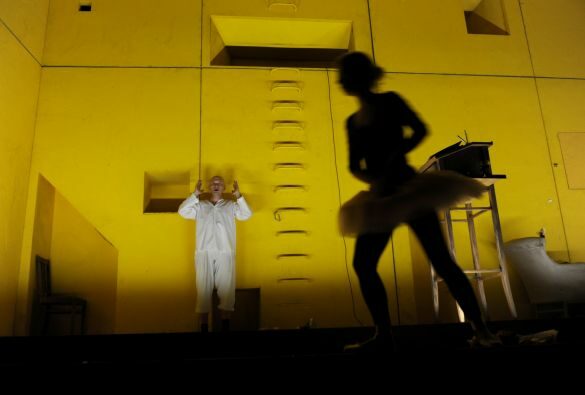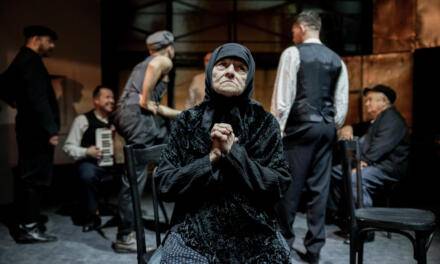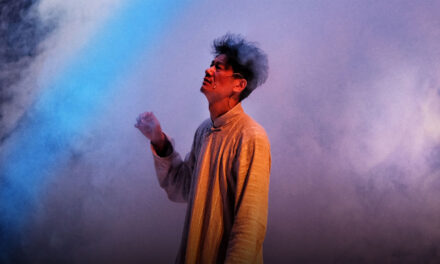After a 24 year hiatus, Russian director Kama Ginkas has again stepped into one of the most famous spaces he ever used to make theater – a white room in a small, 200-year-old Moscow building, a detached, affiliate structure of the Moscow Young Spectator Theater. Ginkas staged one of his most famous productions here in 1991, an adaptation of a few chapters from Fyodor Dostoevsky’s novel Crime and Punishment that he called We Play Crime. The idea then was that Ginkas would use this space regularly for the next 30 or 40 years, and he even came up with a phrase to describe the genre he intended to develop there: Games in a White Room. Life intervened, however, and while he went on to achieve international fame as a challenging, provocative interpreter of Dostoevsky, Chekhov, Shakespeare, Pushkin and other authors, he never again had access to the White Room. Until now, that is. Without fanfare, the Young Spectator Theater in 2015 reclaimed ownership of the small affiliate that stands next to it, and Ginkas did what every thinking person dreams of doing: He stepped into the past in order to leap into the future. The result was On the Road to..., a brilliant new adaptation of Crime and Punishment. John Freedman, whose life was changed by We Play Crime, uses this event to share some thoughts about Ginkas, his art in general, and On the Road to… in particular.
I vividly recall sitting with Kama Ginkas in the upstairs office at Moscow’s Young Spectator Theater. We were deeply engaged in the latest of many marathon conversations, the sum of which would take shape as a book called Provoking Theater. Ginkas was talking about the influence of his childhood home on his perceptions and aesthetics. Here is one snippet that entered the book from that conversation:
“So, I would go into father’s study. There was a box in there with chess pieces. Like all Jews, father played a little chess. It was an old set, and, as I remember it now, the box was large and made of leather. I would put a candle in it, light it, and look at the shadows its flame would cast. I imagined seeing an old king and queen. And all around them, other kings and officers and pawns seemed to be walking about or dancing to music as the candle cast swaying shadows on the chess pieces and the rug.”
Then there was this:
“I remember the light gray, almost beige, striped rug in the living room. The sun would fall through the window on the windowsill and catch just a corner of the rug, the rest of which would remain in stunning, cool shade. For me, this image represents the absolute ultimate in domestic comfort and contentment. I remember badly,but highly polished, surfaces that were not marred by even a speck of dust. There was nothing extraneous on them.”
Light and shade. Dancing or static shadows.
These conversations took place a long time ago, in the year 2000. And I remember how, at the time, my nine-year-old memories of Ginkas’s production of We Play Crime rushed into my head. So, that is where he got those ideas for his lighting! And, now, in November 2015, once again, all of it – We Play Crime, Kama’s childhood home, the conversations we had when writing our book – all came rushing back into my head as I stared ahead at the space in front of me.
There was light streaming in a window, casting crooked grey and black shadows on a whitewashed wall and floor. Areas in the corners, beyond the reach of illumination, remained in stunning, cool shade. This image for me represented the absolute ultimate in theatrical perfection. There was nothing extraneous in it.
I had seen these shadows before, these white walls, the actors shuffling around the perimeters of the room in heavy, floor-length overcoats, the same bucket hanging by a pulley from the ceiling. Yes, of course, I knew it would fall and clatter to the floor – not because, like Chekhov’s rifle, it had to “go off” because it was there, but because twenty-four years ago I sat in this room and saw the same (almost) shadows, the same (almost) overcoats, the same (almost) white walls, and the same (perhaps) painter’s bucket hanging from the ceiling. Kama Ginkas was playing with me, teasing me, provoking me. He was throwing images at me that I knew well, but that I had forgotten, again. Plus, he was giving them to me in a new context. (I can’t, however, share photos of the shadows because Ginkas, ever playing games with his spectators, purposefully keeps them out of publishable images so as not to give anything away in advance.)
We Play Crime focused on a battle of wits between Raskolnikov, the young intellectual who murders two women to test his theory of freedom, and Porfiry Petrovich, a wily detective whose homespun wisdom and perfect professional instinct made him the godfather of all detectives to follow, from Poirot to Columbo. It featured the bizarre comic image of the two murdered bodies, festively dressed, literally waltzing through space from time to time with axes stuck in their heads. That painter’s bucket hanging from the ceiling (because Raskolnikov comes back to the crime scene to check it out when painters are painting out the damned spots where blood was spilled) crashed to the floor at a moment of truth. At one interval, the sneaky Porfiry slipped into the room through a window, surprising Raskolnikov, who wondered if his nemesis had appeared by magic.
Ginkas suckered me on that one. I kept watching the window in On the Road to…, waiting for someone to make their unannounced and unorthodox entrance. But Ginkas turned everything around. In the new show, an individual who is trapped, no less than Raskolnikov, by his past, his sins and his character, attempts to leap out of the room by way of that same, historic window. But he cannot do it. Neither Ginkas nor Dostoevsky will let him go. He is boxed up here in this room, fated to confront not only his evil choices but – every bit as terrible – to consider the sad consequences of possessing flawed character. That should be God’s fault, you would think, but, no, each individual answers for the bad character he or she inherits.
The “he” I describe here is Svidrigailov, the new focus of Ginkas’s return to Crime and Punishment. We Play Crime focused more or less equally on Raskolnikov and Porfiry. One was unimaginable without the other. Call them double-opposites if you will. That might be a tad simplistic, but it is a useful equation. Raskolnikov represented human hubris, the desire to step over the line, to violate the proper laws of man and nature. Porfiry represented common sense, a respect for order in a chaotic world. There is no such dichotomy in On the Road to…. It tells the hard, harsh, sad and very contemporary tale of two men who have lost their way, for whom murder has been a signpost of their lives, though, surely, neither planned it that way. Rather than an opposite, Svidrigailov is a shadow version of Raskolnikov. With the lighting properly set, Svidrigailov casts a shadow that dwarfs Raskolnikov. Svidrigailov probably killed his wife. He probably seduced an under-aged girl. He is a profligate, he is rude and he is crude. But he has the nerve to allow himself to dream of happiness. He loves Raskolnikov’s sister Dunya and will do anything for her. As he tells her, he would be her slave.
Let’s be exact about this, as it is important for an understanding of both Ginkas and Dostoevsky: Svidrigailov does not believe in happiness. He does not believe it can be attained. But if he can imagine it – as he imagines a life with Dunya being one of happiness – he can strive for it anyway. Lack of faith is not enough to stop a man’s dreams and aspirations. For better or for worse, it is not enough to stop him from acting upon whatever impulses he may have. The tension between mutually exclusive reality and desire is what drives Svidrigailov’s tragic character.
“You can’t figure Svidrigailov out,” Ginkas writes in a publicity blurb that preceded the November 11 premiere. “He’s always either joking or being quite serious. He’s either suffering or playing the fool. He’s either going mad or he’s faking it. He’s a hustler, but he rarely lies. He’s a killer, but it’s impossible to prove it. He is a seducer of under-aged girls, but he desperately loves Dunya. Svidrigailov is a philosopher.”
Svidrigailov may be a thinker, like Raskolnikov, but he is older, more experienced, more jaded, and, surely, less of an idealist. He knows that life wears us down at the edges and breaks off of us everything that is not essential. Raskolnikov, fired by thoughts of moral supermen and murder as a useful social tool, wisely or not still entertains notions of the perfection of philosophical and, perhaps, social models. That either irritates Svidrigailov, or makes him laugh. He knows that the bodies left behind us are a form of payment for the right we win in battles to continue living our lives.
Here I am compelled to declare an ill-timed intermission in order to introduce two verses from “Pay in Blood,” one of Bob Dylan’s most enigmatic and powerful songs. I could ignore the inclination and it would make for a neater article. But pardon my writerly clumsiness; I will insist. I have always seen a similarity in Kama Ginkas’s theater and Bob Dylan’s songs, and this strikes me as an opportune moment to make a substantive, though brief, connection between the two. It is not a perfect fit – it cannot be and I don’t claim it is – but consider the following two verses from “Pay in Blood.” Imagine Svidrigailov speaking to Raskolnikov:
Low cards are what I’ve got
But I’ll play this hand whether I like it or not
I’m sworn to uphold the laws of God
You could put me out in front of a firing squad
I’ve been out and around with the rising men
Just like you my handsome friend
My head’s so hard, must be made of stone
I pay in blood, but not my own.
…
How I made it back home, nobody knows
Or how I survived so many blows
I’ve been through Hell, what good did it do?
You bastard! I’m supposed to respect you!
I’ll give you justice, I’ll fatten your purse
Show me your moral virtue first
Hear me holler and hear me moan
I pay in blood but not my own.
Dylan is not writing about Svidrigailov and Raskolnikov, but he is writing about someone who bears a strong resemblance to the former. This is precisely the kind of Svidrigailov that Ginkas coaxes out of his actor Igor Gordin. He is rough. He is preemptive. He is thoughtful, but he slurs his words. He is impatient and imperious. I know Ginkas has never heard “Pay in Blood,” but I hear Ginkas’s Svidrigailov in Dylan’s narrator, as I do in still another Dylan song, “Spirit on the Water”:
I can’t go to paradise no more.
I killed a man back there…
On the Road to… is not so much a case of Ginkas coming full circle to a place where he once was. It is, rather, an older, perhaps wiser, Ginkas peering into his past and looking for signs that lead to his future. Ginkas was 49 when he first worked in this space. He was young, energetic, proudly caustic, his late-blooming career was just beginning to take off. He returns to it now a veteran of 74, with a stash of international awards, productions and laurels behind him. I called Kama after seeing On the Road to… and I told him it looked like a new beginning. He laughed and said, “Oh, I don’t know. I was young and cocky and full of ideas back then. It was a marvellous, important time for me. All I have now is experience and love for these characters.“
In On the Road to… Ginkas reprises those colorful, comic corpses wandering about with axes in their heads. You can see that he loves them. And he makes us love them too, partly through the light, melancholy music that always accompanies their appearances, and partly through the hop, skip and jump he puts into their gait. They brim with life, with energy, with intensity, humor, irony and shrewd skepticism. Raskolnikov refers to them as ghosts; Ginkas designates them in the program as Actors from a Burned-Out Theater. Both are right, for that is what they are – they still wander through this white Dostoevskian, Ginkasite space as though they never stopped for all these decades. Ginkas is anything but sentimental, but who knows, maybe every time he walked past this building for the last quarter century he thought of those dancing, spinning corpses. I know I did not pass by this space once without peering in a window, glancing up at the walls, staring at a door, or thinking about the people who came to life here night after night under Ginkas’s direction in 1991.
Time moved on, but that space for me forever remained the space of Ginkas’s one Game in a White Room, the place where Raskolnikov took on Porfiry Petrovich and lost because life always defeats theory. The very emptiness of the little affiliate building, the lack of any more Kama Ginkas productions within its walls was proof of that – the theory of creating a new genre of white room games fell victim to the vagaries of real estate in the real world.
One assumes it was no easy thing for Ginkas to step back into this space. He told me as much himself. But it was also one of those moments that an artist simply could not ignore: he received the rare opportunity to correct the errors of history. How could he not go back in there? How could he not engage the ghosts that remained there from the past?
In another publicity text, Ginkas wrote, “I have repeatedly sworn off staging Dostoevsky. I staged him in Finland (The Idiot, Crime and Punishment), in Germany (N.F.B., an opera after The Idiot), and, of course at the Moscow Young Spectator Theatre (Notes from Underground, K.I. From ‘Crime’, and A Ridiculous Poem). Twenty-five years ago we opened our new stage called Games in the Affiliate with We Play Crime. And now again! Again, Games in the Affiliate. And again – Dostoevsky.”
I hear two things in those words. I hear weariness and I hear a man overcoming it to accept a challenge. It is the latter of the two that has meaning. On the Road to… brilliantly wraps up one historical cycle and sets the stage for another to come. It obviously had to be done with Dostoevsky. I don’t think any theater director has ever understood Dostoevsky so totally and perfectly as Ginkas has done throughout his career. In fact, I rather suspect Dostoevsky wrote his works holding someone like Ginkas in mind. The match is impeccable.
John Freedman is an American writer and translator who co-wrote Provoking Theater with Kama Ginkas. After closing out 25 years as the theater critic for The Moscow Times in October 2015, he joined the Stanislavsky Electrotheatre in Moscow as Assistant to the Artistic Director.
This post was written by the author in their personal capacity.The opinions expressed in this article are the author’s own and do not reflect the view of The Theatre Times, their staff or collaborators.
This post was written by John Freedman.
The views expressed here belong to the author and do not necessarily reflect our views and opinions.


















